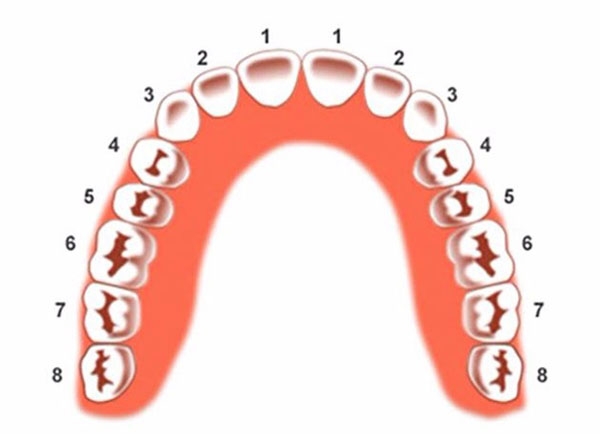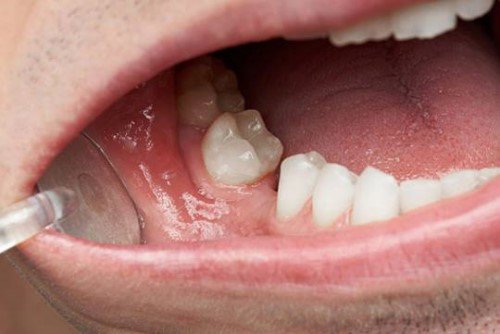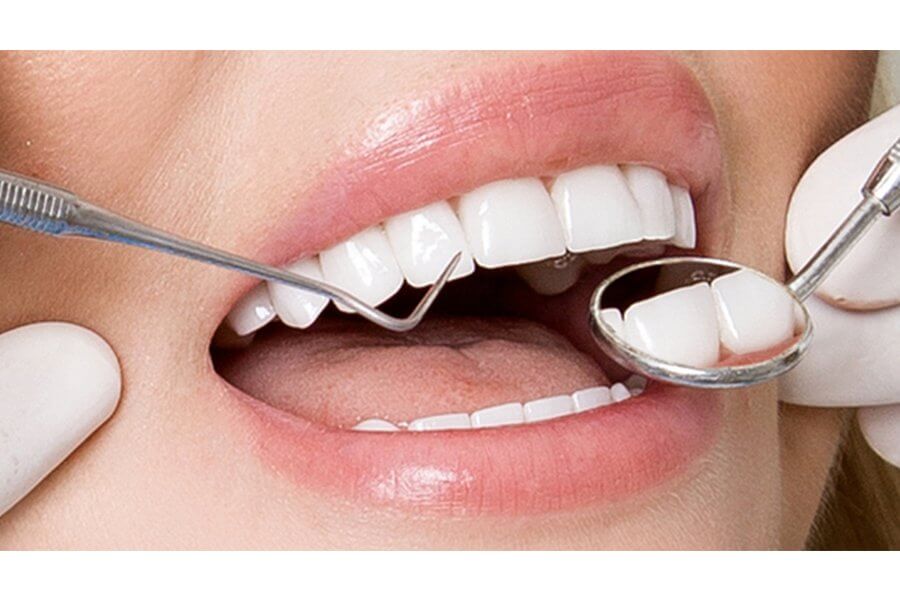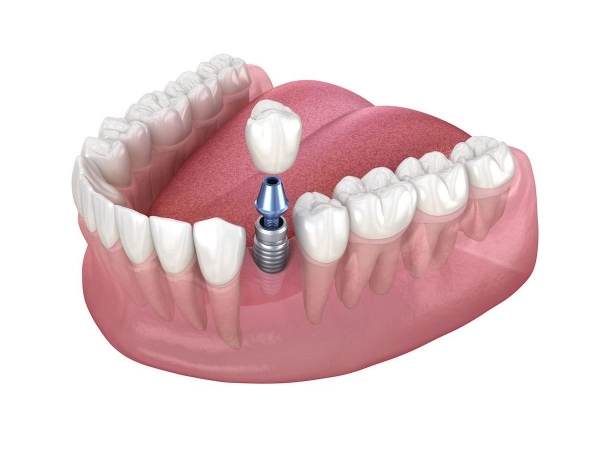Which tooth is number 4 Tooth .Number 4 tooth belongs to the category of small molars in the upper jaw. They are responsible for both chewing and tearing, as well as grinding food. Therefore, the loss of tooth number 4, if not restored early, can lead to serious consequences such as decreased chewing ability, jaw bone resorption, and impact on the lower teeth. so Which tooth is tooth number 4 ?
1. Understanding tooth number 4. Which tooth is number 4 tooth?
Each tooth in the upper jaw has its own name and function, and tooth number 4 is no exception.
Let’s take a closer look at tooth number 4 to understand where it is located in the jaw.
1.1. Which tooth is number 4 tooth?
Tooth number 4 is the largest small molar in the upper jaw, so it is often referred to as the first molar or small molar.
Tooth number 4 consists of a total of 4 teeth, evenly distributed with 2 teeth in the upper jaw and 2 teeth in the lower jaw.
The shape of the tooth is similar to a bishop’s hat, with a large, round, and straight crown. The surrounding surfaces must have a certain sharpness. Therefore, tooth number 4 is responsible for both chewing and swallowing food, similar to canines and upper molars.
1.2. Location of tooth number 4
The location of tooth number 4 is between the canine tooth number 3 and the small molar number 5 in the jaw. In terms of the teeth in the jaw, this is the last tooth.
The reason why it is called tooth number 4 is because it is the fourth in order counting backwards from the last tooth.
1.3. When is it necessary to extract tooth number 4?
When is it necessary to extract tooth number 4? Tooth number 4 is the last molar at the back of the upper and lower jaw, also known as wisdom tooth or third molar. The indication for extracting tooth number 4 depends on several factors, including:
- Positional issues: Tooth number 4 often erupts last, causing difficulties in oral hygiene and may result in impaction or pushing of other teeth in the jaw. If tooth number 4 poses positional issues, such as affecting oral health or causing pain, tooth extraction may be recommended.
- Infection of tooth number 4: If tooth number 4 is infected, tooth extraction may be recommended to prevent the spread of infection to other areas in the mouth.
- Insufficient space for tooth number 4 to erupt: If there is not enough space for tooth number 4 to erupt, it can cause pain, swelling, or damage to other teeth. In this case, tooth extraction may be recommended.
However, the decision to extract tooth number 4 depends on each specific case and should be performed after consultation with a specialized dentist. If you have any issues with wisdom teeth or tooth number 4, consult a dentist for the best treatment method.
1.4. The difference between extracting tooth number 4 and regular tooth extraction
Extracting tooth number 4 and regular tooth extraction have certain differences. Here are some key differences between extracting tooth number 4 and regular tooth extraction:
- Location: Tooth number 4 is usually located at the back corner of the upper or lower jaw, while regular teeth are located at different positions in the jaw.
- Size: Tooth number 4 is usually smaller in size compared to regular teeth.
- Shape: Tooth number 4 has a more unique shape, often triangular and not fully developed during growth.
- Position in the jawbone: Tooth number 4 is usually close to nerves and other soft tissues, so extracting tooth number 4 can be more painful and challenging compared to regular tooth extraction.
- Extraction method: Extracting tooth number 4 usually requires a specialized extraction method to remove the tooth and minimize the impact on surrounding tissues.
- Recovery process: The recovery process after extracting tooth number 4 may take longer compared to regular tooth extraction due to the position and complexity of the tooth.

In summary, extracting tooth number 4 is usually more difficult than regular tooth extraction due to the complexity of the tooth and the surrounding tissues. Therefore, understanding and performing the process of extracting tooth number 4 should be done by a dental expert to ensure safety and effectiveness.
2. Consequences of losing tooth number 4

Although it is not a tooth that holds a very important position in the dental arch, losing tooth number 4, especially the first molar, can still cause certain consequences.
There are 4 consequences that you will have to face if you lose tooth number 4 without any corrective measures, which are the impact on chewing ability, jaw bone resorption, and the impact on adjacent teeth causing serious aesthetic issues.
2.1. Impact on chewing function
Regardless of their position in the dental arch, the teeth in the upper jaw all participate in the chewing function with specific tasks of tearing and grinding food.
As mentioned earlier, the function of tooth number 4 is only to assist in chewing food for the canine teeth and grinding food with the larger molars.
Therefore, when tooth number 4 is lost, the chewing function will be somewhat affected.
Furthermore, during the process of eating raw food, if the food is not cooked thoroughly or chewed properly, it can become a burden on the digestive system, leading to various gastrointestinal issues such as stomach pain, colitis, and hemorrhoids.

2.2. Jaw bone resorption
Jaw bone resorption is considered an inevitable consequence that occurs when you lose tooth number 4 but do not promptly replace it with artificial tooth implant.
This is explained by the fact that the jaw bone in the position of the missing tooth number 4 will begin to deteriorate as there is no chewing force exerted on it.
The density, volume, and mass of the bone will gradually decrease starting from the third month after tooth loss.
2.3. Impact on adjacent teeth
When tooth number 4 is missing, it directly affects the adjacent teeth, which are tooth number 3 and tooth number 5. It also causes the surrounding teeth to shift, as these teeth tend to tilt toward the empty space left by the missing tooth in the dental arch.

Moreover, the position of the dental arch becomes more difficult to clean, becoming a place where plaque and food debris accumulate. This increases the risk of developing oral diseases such as gingivitis, gum ulcers, and tooth decay.
2.4. Aesthetic impact
Although it is not located in the center position of the anterior teeth, when talking or laughing loudly, we can easily notice tooth number 4.
Therefore, if tooth number 4 is lost, it will leave a large gap and this is also a limitation in terms of aesthetics.
Not to mention, if there is a case of a broken jaw bone and the group of upper teeth in the dental arch is misaligned, it will greatly affect the overall facial aesthetics.
3. Methods for restoring lost tooth number 4
For cases of missing tooth number 4, you can restore it using 3 methods: removable denture, fixed porcelain bridge, and dental implant.
3.1. Removable denture
Removable dentures have been a long-standing method of dental restoration, but they still maintain a certain appeal to this day. Especially for older customers, this may be the method they first consider.
The reason is that this method of restoration is low-cost, the implementation time is simple, and it can be easily removed and reinserted.
Removable dentures consist of a denture base or a framework (usually made of rubber), with artificial teeth made of glass or porcelain on top.
Since this restoration method has been around for a long time, there are still some limitations to removable dentures:
– Users may feel loose while chewing, and the teeth may come out.
– It only restores about 30 – 40% of chewing function.
– The lifespan of use is very short, about 3 – 5 years.
– It does not prevent jaw bone resorption.
– It often causes gum swelling.
3.2. Fixed porcelain bridge
A fixed porcelain bridge is a highly evaluated and safer method of restoring tooth number 4 compared to removable dentures. Additionally, this is also a method of restoring missing teeth in a fixed manner.
To proceed with this method, dentists will grind the adjacent natural teeth on both sides into abutments, and then place a new porcelain bridge to replace the missing tooth. The upper part of the porcelain bridge will consist of at least 3 interconnected porcelain teeth.
The advantages of a fixed porcelain bridge are its stability, not requiring removal and reinsertion for daily use and chewing. It helps to restore about 70% of chewing function and has a lifespan of 7 – 10 years.

However, over time, the phenomenon of bone resorption occurs, causing the gum to recede and exposing the denture.
On the other hand, the two abutment teeth, when worn down, can no longer support chewing, and over time, they have become significantly weaker.
3.3. Dental Implant
It can be said that dental implant is the best and most advanced method of restoring missing teeth up to this point.
With a structure consisting of an implant fixture, an abutment connector, and a porcelain crown, it provides a comprehensive solution for restoring a damaged dental arch.
The implant fixture will be attached to the lower jawbone to replace the root of the tooth. As a result, the overall dental arch will be very stable, helping to restore chewing ability almost completely.

The lifespan of an Implant tooth can be up to 25 years, if cared for properly it can last a lifetime.
Furthermore, this is a method that completely solves the problem of jaw bone fractures caused by long-term tooth loss.
However, implanting teeth also has certain limitations, such as a long implementation time (around 3-6 months) and a relatively high cost.
4. Answering questions when extracting tooth number 4
To provide you with more useful information, we will answer some common questions when extracting tooth number 4, such as how long it takes to heal, any issues, and whether it is painful.
4.1. How long does it take to heal after extracting tooth number 4?
The healing time after extracting tooth number 4 does not have a specific time frame and depends on various factors. These include individual factors, the skill of the dentist, and the tooth extraction technique.
After extracting the tooth, the swelling and pain will gradually decrease within 2-3 days.
After about 1-2 weeks, the wound will start to heal, but it takes 1-2 months to completely fill the tooth socket or permanently heal.
It takes 1-2 months for tooth number 4 to fully heal.
4.2. Does extracting tooth number 4 have any impact?
Extracting tooth number 4, if done at a reputable dental clinic, will not have any negative impact on your health.
However, in the long term, not restoring the missing tooth can significantly affect oral health and facial aesthetics.
4.3. Is extracting tooth number 4 painful?
During the process of extracting tooth number 4, there will be no pain due to the use of anesthesia and advanced technology.
Moreover, once the anesthesia wears off, you will be given pain medication, so the pain will not significantly affect your daily life.
4.4. Is extracting tooth number 4 dangerous?
Due to its relatively small size and less complex position compared to wisdom teeth, the process of extracting tooth number 4 does not pose any significant danger.
However, it is important to note that this is only guaranteed when you have the procedure done at a reputable dental clinic.
Extracting tooth number 4 is not dangerous if done at a reputable address.
4.5. Does extracting tooth number 4 reduce lifespan?
Based on in-depth scientific research, extracting tooth number 4 DOES NOT reduce your lifespan.
Although there may be certain negative impacts, extracting tooth number 4 will not decrease your lifespan.
4.6. Does extracting tooth number 4 cause facial sagging?
If the missing tooth number 4 is not restored for a long time, it can lead to jaw bone fractures.
At this point, your cheek may swell, and the skin in the chin area may sag, making you look older than your age.
4.7. How many roots does tooth number 4 have?
Tooth number 4 in the lower jaw has one root, while in the upper jaw, it can have one or two roots.
Due to the small number of roots, the process of extracting tooth number 4 does not take much time but requires complex procedures.
Tooth number 4 in the lower jaw has one root, while in the upper jaw, it can have one or two roots.
4.8. Does tooth number 4 get replaced?
During the lifespan of tooth number 4, it will be replaced once, during the transition from baby teeth to permanent teeth.
We hope that this article about tooth number 4 has provided you with a lot of useful information. If you need more information about the extraction and restoration of tooth number 4, you can contact the hotline or visit Bedental Dental Clinic for the most detailed guidance.
4.9. Risks that can occur when extracting tooth number 4
Extracting tooth number 4 is a minor surgical procedure, but it can still pose certain risks. The following are the risks that can occur when extracting tooth number 4:
- Pain: Pain is a common reaction after extracting tooth number 4, and it can last for a few days or even weeks.
- Infection: Infection is a common risk associated with extracting tooth number 4. The use of unclean medical devices or poor oral hygiene can cause infection.
- Bleeding: Bleeding is another risk associated with extracting tooth number 4. If bleeding does not stop within a short period of time, the tooth extraction process may need to be repeated or other measures taken to control bleeding.
- Tumor recurrence: If tooth number 4 is extracted due to a tumor or its position causing difficulties, there may be a risk of tumor recurrence.
- Damage to surrounding tissues: The process of extracting tooth number 4 can cause damage to surrounding tissues, such as nerves or blood vessels, causing pain or permanent damage.
- Allergic reactions: Some people may have allergic reactions to local anesthesia or antibiotics used during the tooth extraction process.
- Difficulty in opening the mouth or swallowing after extracting tooth number 4.
To minimize these risks, the process of extracting tooth number4 should be performed by a skilled and experienced dentist. It is also important to follow post-operative instructions and maintain good oral hygiene to reduce the risk of infection and other complications. If you experience any unusual or severe symptoms after extracting tooth number 4, it is important to contact your dentist for further evaluation and treatment.
Tư vấn chuyên môn bài viết:
BÁC SĨ ĐÀM TRỌNG HIẾU
BEDENTAL - TOP STANDARD DENTISTRY SYSTEM
In HANOI
Address 1: 7B Thi Sach St, Ngo Thi Nham, Hai Ba Trung Dist, Ha Noi. - 0934.61.9090
Address 2: No 129 Hoang Ngan, Yen Hoa, Cau Giay Dist, Ha Noi. - 0934.61.9090
In HO CHI MINH
Address 1: 53 -55 -57 Pho Duc Chinh St, Nguyen Thai Binh, Dist. 1, Ho Chi Minh. - 0766.00.8080
Working: 9am - 8pm everyday
Website: https://bedental.vn/en/






Pingback: Should You Get Diamond-Encrusted Teeth – Some Insights from Experts – Be Dental
Pingback: Wearing a retainer – Things to note – Be Dental
Pingback: Experiencing Numbness After Wisdom Tooth Extraction and Some treatment methods – Be Dental
Pingback: Experiencing Sensitivty After Wisdom Tooth Extraction and Some treatment methods – Be Dental